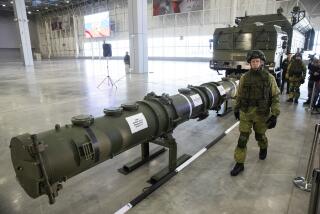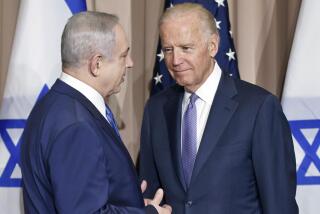Do a Missile Defense, but Do It Right
The Bush administration is right to want a missile defense system for the United States and its allies. The gradual spread of long-range missiles makes it desirable, and improvements in technology should soon make a limited capability possible. In addition, the end of the Cold War means that Moscow and Washington should no longer cling to the 1972 ABM treaty to constrain what is left of their nuclear rivalry.
President Bush has made these points to British Prime Minister Tony Blair, and Secretary of State Colin Powell has made them to a skeptical Igor S. Ivanov, Russia’s foreign minister. However, neither Bush nor Powell provided specifics. As Powell said, “We’re still working on our concept and program.”
Fair enough. But it is important to get national missile defense right. The wrong NMD would be worse than none at all.
As the Bush administration fashions its plan for missile defense, it should keep several key criteria in mind. First, and most obviously, NMD must work, not only on the test range but against an adversary trying to defeat it. Second, it must be affordable, given the competing demands on the Pentagon purse and the need to improve other defenses of the American homeland against threats such as “suitcase bombs” and cruise missiles. Third, it must protect not just the U.S. but its allies. Otherwise, the Saddam Husseins of the world could blackmail us by threatening Paris or Prague rather than Washington or Atlanta.
Finally, although we should not give Russia and China a veto over our deployment of missile defenses, any deployment must anticipate their likely responses. Otherwise the U.S. and its allies could wind up less, rather than more, secure.
For example, Russia might suspend the bilateral Nunn-Lugar program to downsize and secure its frighteningly dilapidated nuclear weapons capabilities--on the grounds that the U.S. was rekindling a nuclear competition and hence could not be trusted with information about the location of Russia’s nuclear capabilities.
In that event, the NMD cure could be worse than the disease, since Russian loose nukes are a greater potential threat to U.S. security than North Korean or Iranian ICBMs. Likewise, Russia or China might step up efforts to help “rogue states” (now “states of concern”) improve their missile forces as retribution for a U.S. missile defense they saw as hostile.
There is a way to satisfy these criteria. It requires moving beyond the usual dialogue of the deaf between NMD opponents and proponents.
At the strategic level, the U.S. must recognize that only a limited missile defense system targeted on small, extremist states makes sense. Any effort to build a large NMD capable of defeating Russian or even Chinese nuclear forces is bound to fail in military terms, and to greatly worsen relations with those countries, setting back international efforts to stem proliferation.
At the technical level, the U.S. and its allies should focus their efforts on so-called boost-phase defenses that would shoot down enemy missiles early in their flights. Such defenses are much more resistant to the decoys and other countermeasures that an adversary would surely try to develop to counter NMD. They should also reassure China and Russia that America’s NMD will not be able to target their missiles. Because boost-phase interceptors seek to shoot down threatening enemy missiles shortly after launch, they have to be based near those missiles. That means that ICBMs located in the interior of Russia and China could not be intercepted by boost-phase defenses, unless those defenses were based in space, which, in any event, is not a viable technical proposition for the next 15 to 20 years.
Finally, the Bush administration should continue to take its time. For the next few months, it should make clear its intention to deploy some type of national and allied missile defense, seek international support for that position, accept allied advice on what type of defenses to build and avoid any treaty-busting decisions.
The idea of some conservatives that the ABM treaty should be jettisoned quickly is a very bad one. It would cause tremendous international fallout without advancing one iota the speed at which missile defense could be deployed. Specifically, the Bush administration should resist any temptation to authorize construction of a radar on Shemya Island in the Aleutians this year.
A defense system meeting these criteria should retain the ABM treaty’s original limit of 200 interceptor missiles. Even if this defense also included a small backup capability based on the Clinton administration’s concept, but located in North Dakota rather than Alaska and involving no more than 25 to 50 interceptors for now, total costs would be no more than $30 billion to $35 billion. That’s expensive but considerably less than what the full Clinton proposal would have entailed, and perhaps only a quarter as much as the system proposed by former President Bush. It would also defend our allies. That’s the plan Bush and Powell should try to sell the Blairs and Ivanovs of the world.
More to Read
Sign up for Essential California
The most important California stories and recommendations in your inbox every morning.
You may occasionally receive promotional content from the Los Angeles Times.










